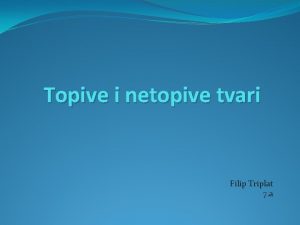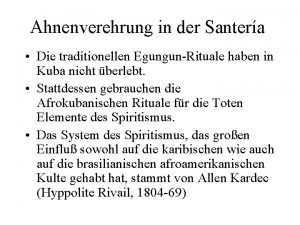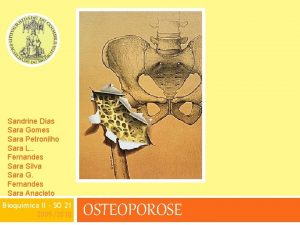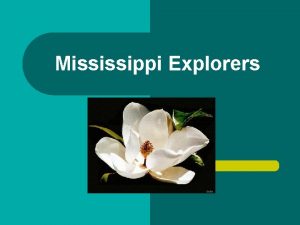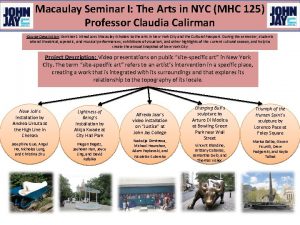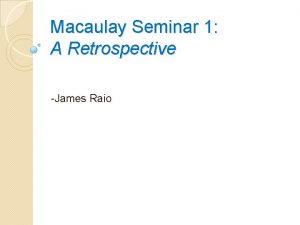Santera Sara Filip Macaulay Seminar Professor Soto ORIGIN














- Slides: 14

Santería Sara Filip Macaulay Seminar Professor Soto

ORIGIN v. Afro-Cuban religion v. Began in 16 th century Cuba v. Africans were transported to the Caribbean during the slave trade v. Many slaves practiced the Yoruba religion v. Forced to convert to Catholicism v. Mixed Yoruba beliefs with Catholic practices to avoid religious persecution v. Based mainly on traditional Yoruba beliefs, with Catholic influences

FUNDAMENTAL BELIEFS v. In spanish, Santería translates to “worship of the saints” v. Centered around the belief in a distant Supreme Being, often referred to as Olodumare, Olorun, and Olofi v. Worship of the Orisha (santos), created by the Supreme Being v. Ritual dance; chants performed in Yoruba accompanied by drums; ceremonial spirit possession; ancestor veneration; and, on occasion, animal sacrifices

THE ORISHA v. Powerful spiritual beings v. Sent by Olodumare to populate and civilize the Earth v. Compared to the saints of Catholicism v. Have the power to bring prosperity or misfortune v. Are worshipped, prayed to, and provided offerings v. Followers show respect through prayer, song and dance, sacrificial rituals, and offerings

Ebó: An Offering to the Orisha v. Ritual offerings are called ebó v. A tool given by the Orishas to change one’s fate and return their life to a balanced and healthy state v. Fresh fruits, cooked foods, ritual baths, undergoing initiation, receiving an Orisha, animal sacrifice, and many more v. Each Orisha has individual preferences for what should be offered

MINGLING OF RELIGIONS v. African slaves attributed each of their saints to a figure from the Catholic church v. They had to convince others that they were assimilating v. Hid their Yoruba beliefs beneath catholic figures

SAINT LAZARUS v. Catholic figure of Saint Lazarus, is connected with Babalu-Aye, the African spirit of healing; can grant someone good health, or take it away v. Babablu Aye, San Lazaro, Azojano v. One of the most loved, respected, feared and venerated Orishas v. Worship of Saint Lazarus has become a national practice v. December 17 th, Cubans participate in a mass pilgrimage to the Rincon sanctuary v. People dress in purple to honor the saint, and bring him offerings

SAINT LAZARUS v https: //video. nationalgeographic. com/video/cuba-santeria-pp

Botánicas v. Botany stores that sell medicinal plants, religious objects, and other artifacts for physical and spiritual healing v. Establishments that sold medicinal plants in Latin America v. Traditional, medicinal approach to healing is usually mixed with spiritual practices v. Native medical traditions can cross with religious beliefs v. Most are run by Santeros/Santeras v. These priests can communicate directly with the Orishas and help guide believers when they come in search of answers and support

Botánicas v. Rudy Guardiola: Santero; owns and runs a botánica in New York City v Immigrated from Cuba in 1980 during the Mariel boatlift v. Opened The Church of the Orishas in the basement below the botánica v. Conducts consultations, readings, and cleansings v. A santero provides the people with direct messages from the Orisha v. Provide a strong sense of community, togetherness, and are a safe space for anyone in need of guidance.


Santería and the immigrant experience v. Cuban immigrants who left in the 1960 s and then again in the 1980 s, spread Santería throughout the city by opening up botánicas v. Santería brings people together and offers them freedom of expression; familial environment v. Cubans’ psychological and physical need for belonging was met through faith (De La Torre 192)

Santería and the immigrant experience v. Botánicas offer solutions to physical and mental health issues v. Immigrants often have limited access to health care; additional place they can go for help v. Supplied the Cuban population with a community that was their own v. Orishas provide believers with figures to turn to in times of trouble v. Sense of guidance and security

Works Cited • Babu, Chaya. “Finding Help and Healing Through Santeria. ” Buzzfeed News. 2016. https: //www. buzzfeed. com/chayababu/finding-help-and-healing-throughsanteria? utm_term=. uq 1077 jxx#. xxg. Dkk. V 33 • Brandon, George. “Santeria. ” Encyclopedia of African Religion. 2009, pp. 589 -593. • De La Torre, A. Miguel. Santeria: The Beliefs and Rituals of a Growing Religion in America. Aug 2004. • How Latinos use alternative medicine and botanicas for their health. ” Consumer Reports. 2012 www. consumerreports. org/cro/2012/02/is-it-safe-to-buy-herbs-from-botanicas/index. htm • Pardo Cruz, Elvira. “Saint Lazarus Day in Cuba: Beyond Faith. ” Havanna Times. 2014. https: //www. havanatimes. org/? p=108066 • “Rituals and Sacrifice (Ebó). ” Santeria Church of the Orishas. http: //santeriachurch. org/ourservices/ritual-and-sacrifice/ • “Santeria. ” National Geographic. https: //video. nationalgeographic. com/video/cuba-santeria-pp
 Sara filip
Sara filip Deflection of beams macaulay's method
Deflection of beams macaulay's method Brian macaulay
Brian macaulay Macaulay allergy
Macaulay allergy Macaulay culkin narkotyki
Macaulay culkin narkotyki Bond portfolio immunization
Bond portfolio immunization Duration của trái phiếu
Duration của trái phiếu Dr lemer nyc
Dr lemer nyc Dr andrew macaulay
Dr andrew macaulay Macaulay carson culkin
Macaulay carson culkin Promotion from associate professor to professor
Promotion from associate professor to professor Filip fiala
Filip fiala Karadjordjevic dynasty
Karadjordjevic dynasty Filip triplat
Filip triplat Filip meniny
Filip meniny













